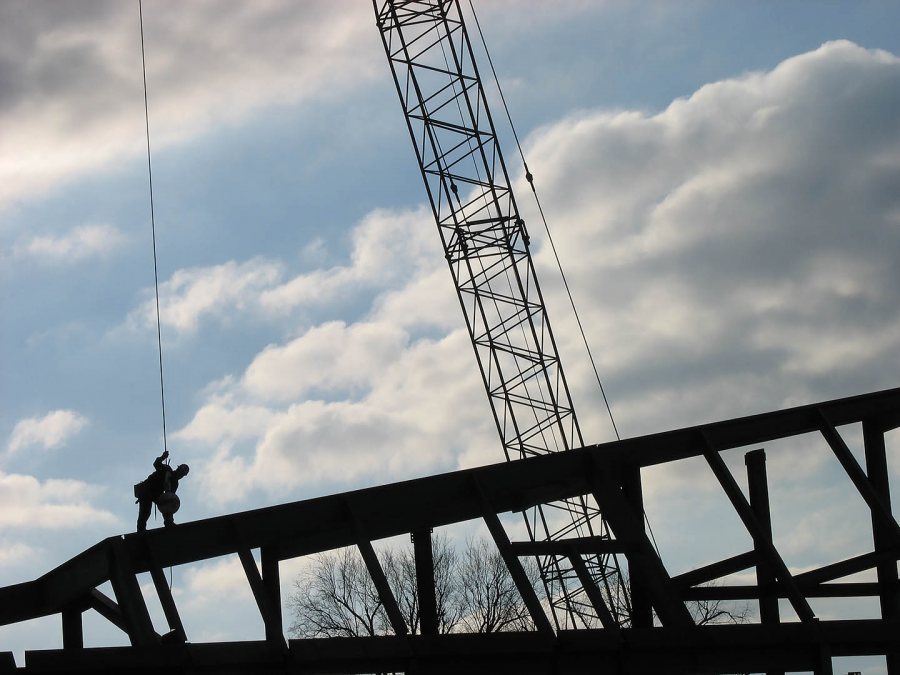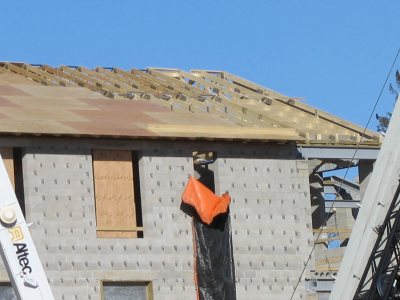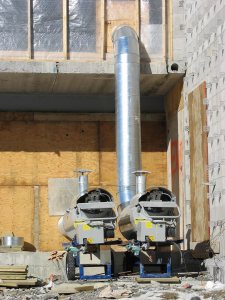
Campus Construction Update: Week of Jan. 29, 2007

Look, skywalker: On the skeleton of the new dining Commons, a worker unhooks a newly set piece of steel from the crane. (Doug Hubley/Bates College)
Considering how much trouble a Maine winter can cause when it really wants to, the people handling Bates’ major campus-improvement projects have gotten off easy so far. Snow has been minimal, and only during the past couple of weeks have temperatures dropped to something like normal.
Lucky weather, top-notch planning and good contractors have kept the new student housing and dining Commons-Bates Walk projects on schedule.
Still, no one’s taking good weather for granted. According to project manager Pam Wichroski, top priority on the housing work now is making that three-section building next to Mount David weathertight by the end of February.
“We’re trying to step up the pace,” she said, which among other measures has meant weekend work for the builders. “In case there is snow, we don’t want it to delay us.”
“Weathertightness” entails getting roofs in place and windows covered with polyethylene sheets, objectives well under way. Installation of roof panels is well along on the eastern wing, aka “flanker,” with the western close behind. Supports for the center section’s roof are going up now.
Bates has the contractors provide their own electricity and heat, Wichroski noted. “It’s all in their name until they turn the building over to us,” she explained — even though the steam line from the central heating plant is alive in the new housing, pushing steam through to adjacent Rand Hall.
That promotes energy consciousness among the builders. Since they’re footing the bills, Wichroski said, “they try to make sure that everything’s tight and the windows are poly’d off to contain the heat.” It’s not an uncommon arrangement, she added, but neither is it standard.
Dining Commons: As for the dining facility, due to open around this time next year, “we put an aggressive schedule on the contractors,” Consigli Construction Co. of Milford, Mass., said project manager Paul Farnsworth.
The recent cold hasn’t made much difference to the pace of progress, Farnsworth explained. The arctic air arrived at a good point: The current focus is the completion of the building’s steel frame, and no major concrete or masonry work is happening. Concrete and mortar need warmth for their strengthening chemical reactions to take place, necessitating the use of heaters and wrappings. But steel just doesn’t care, although the steelworkers might.
Farnsworth reported that three more truckloads of steel for the building’s framework arrived on Jan. 26, at least a week earlier than previously announced. It’s bound for the southeast corner, next to Alumni Gym, where the open kitchen and servery areas will be situated in the finished Commons.

Placement of roof panels on the west wing of the new student housing is nearly done. (Doug Hubley/Bates College)
Notes from Underground: If you have strolled by the Commons site lately, you couldn’t miss a new hole in the ground that’s big enough to play tennis in. This, said Farnsworth, is where all the runoff from the Bates Walk will drain before its next stop, Lake Andrews. The arrangement keeps stormwater out of the public sewer system.
Plastic cells, resembling a honeycomb, buried in the pit will detain the runoff so that it can drop sediments and then flow into the pond at a measured rate — “so that you don’t get a huge slug of water during a storm.”
Why is the pit so big? “It’s large and deep because obviously we have to drain all the way from the other end of the Bates Walk,” at College Street. (See a campus map.) “So there’s a slope to the pipe.”
Talk to Us: What do you think about the campus improvements process? What would you like to know about it? What do you know that we don’t? We want to hear from you — please e-mail your questions and comments to Doug Hubley, with “Construction Update” in the subject line.





